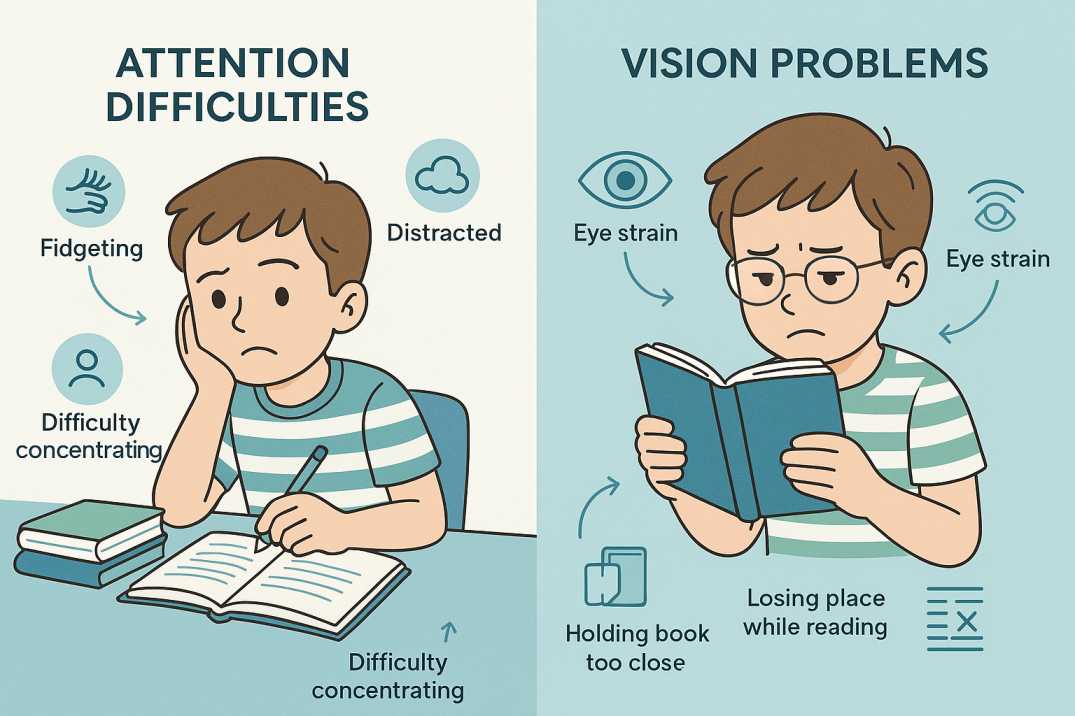ADHD and Vision: How Eye Problems Affect Attention
When a child struggles to focus in school, parents and teachers often think of ADHD first. But what if the real culprit is hiding in plain sight—right in their field of vision? Research reveals a surprising connection between attention problems and visual disorders that’s transforming how we understand and treat inattention in children and adults.
The Hidden Link Between ADHD and Vision Problems
Picture this: You’re trying to read a book, but the words keep blurring and doubling. Your eyes feel strained, and you have to constantly re-read sentences to understand them. After 10 minutes, you’re exhausted and can’t concentrate anymore. Would you be able to focus? Probably not—but you might be mistaken for having ADHD.
Studies show that children with vision problems are nearly twice as likely to be diagnosed with ADHD compared to children without vision issues, with diagnosis rates of around 15.6% versus 8.3%. This striking statistic raises an important question: Are some children being misdiagnosed with ADHD when they actually have treatable vision problems?
Understanding the Connection
ADHD is a neurodevelopmental condition affecting approximately 5% of children and 3% of adults, characterized by inattention, hyperactivity, and impulsiveness. While ADHD doesn’t directly cause vision problems, the relationship between the two conditions is more complex than many realize.
Vision problems, particularly subtle eye misalignment issues like Binocular Vision Dysfunction, can mimic or worsen ADHD symptoms. When your eyes struggle to work together properly, your brain has to work overtime to create a single, clear image. This constant effort drains mental resources, leaving less energy for attention, focus, and learning.
Common Vision Problems That Affect Attention
Convergence Insufficiency: The ADHD Imposter
Convergence insufficiency occurs when the eyes have difficulty turning inward together to focus on close-up objects like books or tablets. This condition affects an estimated 2% to 13% of children in the United States, but the prevalence jumps dramatically in children with ADHD.
Research has found a threefold greater incidence of ADHD among patients with convergence insufficiency compared to the general population. The symptoms overlap significantly:
-
Convergence Insufficiency Symptoms:
- Double or blurred vision when reading
- Frequent loss of place while reading
- Difficulty concentrating on near work
- Eye strain and headaches
- Slow reading speed
- Poor reading comprehension
-
ADHD-Like Behaviors:
- Avoiding reading tasks
- Appearing inattentive during schoolwork
- Restlessness when doing homework
- Difficulty completing assignments
Can you see how easily these could be confused? A child with convergence insufficiency might avoid reading not because they’re hyperactive or inattentive, but because it’s physically uncomfortable and exhausting for their eyes.
Binocular Vision Dysfunction (BVD)
Binocular Vision Dysfunction occurs when the two eyes have difficulty working together to create a single clear image. The body attempts to correct this misalignment by overusing and straining the eye muscles, leading to symptoms that mirror ADHD:
- Headaches and dizziness
- Difficulty reading and comprehension problems
- Poor concentration and focus
- Motion sickness
- Anxiety in visually demanding situations
- Avoidance of schoolwork
Many individuals with BVD are misdiagnosed with ADHD because the symptoms—difficulty with focus, reading, and attention span—are remarkably similar. The connection lies in how the brain processes visual information. When eyes are misaligned, the brain struggles to merge two images into one clear picture, creating constant mental effort that manifests as “inattention.”
Astigmatism and Refractive Errors
Studies have identified increased rates of astigmatism, hyperopia, and other refractive errors in individuals with ADHD. When a child’s vision is blurry due to uncorrected refractive errors, they may:
- Squint or rub their eyes frequently
- Complaint of headaches
- Hold books very close or very far away
- Avoid visually demanding tasks
- Appear distracted or inattentive
These behaviors can easily be mistaken for ADHD symptoms, especially if the vision problem is mild enough to go undetected in a standard school vision screening.
Strabismus (Eye Turn)
Meta-analyses have shown that strabismus occurs at nearly twice the rate in people with ADHD compared to those without. When one or both eyes turn inward or outward, it can cause:
- Double vision
- Reduced depth perception
- Difficulty with sports and physical activities
- Social anxiety about appearance
- Reading difficulties
The Science Behind the ADHD-Vision Connection
Shared Neural Pathways
Why do ADHD and vision problems so often occur together? The answer lies in the brain.
The brain and eyes develop from the same embryonic tissue in early development, which means that changes in early growth can affect both the nervous system and vision. This shared developmental origin helps explain why neurodevelopmental conditions like ADHD can be associated with visual processing issues.
The Dopamine Connection
Dopaminergic neurons—special nerve cells that control dopamine—are present not only in the brain but also in the retina, where they play important roles in vision. Dopamine is crucial for:
- Attention and focus
- Reward-seeking behavior
- Motivation
- Visual processing, including contrast sensitivity and color perception
- Retinal function
Problems in dopamine pathways could lead to both ADHD symptoms and issues with visual processing. This overlap may explain why some children with ADHD are more likely to experience vision problems compared to their peers.
Executive Function and Visual Processing
Visual skills deficits can negatively affect a child’s executive function—the skills and thought processes involved in organizing work, planning, paying attention, and processing information.
Think of it this way: If your child’s brain is constantly working overtime to compensate for vision problems, there’s less mental energy available for:
- Sustained attention
- Working memory
- Organization
- Planning and problem-solving
- Emotional regulation
This explains why treating vision problems can sometimes dramatically improve attention and behavior—it frees up cognitive resources that were being used to compensate for visual dysfunction.
Can Vision Problems Cause ADHD?
Here’s what the science says: Vision problems don’t cause ADHD, but they can:
- Mimic ADHD symptoms, leading to misdiagnosis
- Worsen existing ADHD symptoms, making them more severe
- Co-exist with ADHD, creating a “double burden” that makes functioning even more difficult
Currently, ADHD is believed to be related to alterations in brain structures and neural pathways responsible for executive functions, while convergence insufficiency may be linked to changes in the brain and is commonly seen following brain injury or concussion. They’re separate conditions, but they may share some underlying pathology.
The Misdiagnosis Problem: When It’s Vision, Not ADHD
Studies show up to 15% of children with convergence insufficiency meet the diagnostic criteria for ADHD. This means that a significant number of children might be:
- Taking unnecessary ADHD medication
- Missing out on effective vision therapy
- Struggling in school despite treatment
- Experiencing side effects from medications they don’t need
Red Flags That Suggest a Vision Problem
Your child might have an undiagnosed vision problem if they:
- Only show symptoms during visual tasks (reading, writing, homework)
- Cover or close one eye when reading
- Tilt their head at odd angles
- Complain of double vision or moving text
- Rub their eyes frequently
- Get headaches primarily during or after reading
- Have good attention for non-visual activities, but struggle with reading
The symptoms of convergence insufficiency can make it difficult for students to concentrate on extended reading and overlap significantly with those of ADHD. That’s why a comprehensive vision evaluation should always be part of an ADHD assessment.
Recent Scientific Evidence (2023-2025)
Landmark Meta-Analysis
A comprehensive 2022 systematic review and meta-analysis examined over 3.25 million participants across 42 studies. The researchers found compelling evidence of associations between ADHD and:
- Convergence problems: Five times higher risk of reduced near point of convergence
- Astigmatism: 79% increased risk
- Hyperopia: 79% increased risk
- Strabismus: 93% increased risk
- Accommodative dysfunction: Increased lag and variability in focusing ability
Importantly, the study found that ADHD is associated with functional vision problems but not with structural alterations of the eye itself. This suggests that the connection is neurological rather than purely optical.
Vision Therapy Success Rates
A 2014 study examined children with both ADHD symptoms and convergence insufficiency who underwent 12 weeks of vision therapy. The results were remarkable:
- Near point of convergence improved significantly (from 11.50 cm to 4.38 cm)
- Positive fusional vergence increased dramatically
- ADHD rating scores decreased below the threshold suggestive of ADHD
In clinical trials, children with ADHD who received vision therapy for convergence insufficiency reported fewer vision-related symptoms and stated that reading became easier after treatment.
Recent Prevalence Studies
A 2025 study published in Ophthalmic and Physiological Optics found that the prevalence of convergence insufficiency in ADHD children depends significantly on the diagnostic criteria used. When two parameters were considered (near point of convergence and positive fusional vergence), a significantly higher prevalence was found in the ADHD group.
The researchers hypothesized that decreased performance on binocular tests requiring sustained effort might be due to inattention rather than primary visual dysfunction—highlighting how ADHD and vision problems intertwine.
Treatment Options: Addressing Both Conditions
Comprehensive Vision Evaluation
Eye specialists called optometrists or ophthalmologists diagnose convergence insufficiency and other functional vision problems. A comprehensive exam should include:
- Visual acuity testing
- Refraction (glasses prescription)
- Eye teaming and tracking assessments
- Near point of convergence measurement
- Accommodative (focusing) function tests
- Binocular vision evaluation
Important: Regular school vision screenings typically only check distance vision and cannot detect functional vision problems like convergence insufficiency.
Vision Therapy: The Research-Backed Solution
Vision therapy involves specialized visual exercises that retrain the eye muscles and improve how the eyes and brain work together. The treatment typically includes:
- Home-based exercises: Daily activities to improve convergence and focusing
- Office-based therapy: Weekly sessions with specialized equipment and supervision
- Duration: Usually 12-24 weeks for optimal results
Research shows that vision therapy can significantly improve ADHD symptoms in children with convergence insufficiency, with many patients experiencing permanent improvement after about 12 weeks of consistent practice.
Prism Glasses
Specialized lenses called prism glasses contain micro-prisms that bend incoming light to compensate for eye misalignment. These can:
- Provide immediate symptom relief
- Reduce eye strain and headaches
- Improve reading comfort
- Serve as a temporary solution while vision therapy progresses
Many patients report feeling immediate relief when first wearing prism glasses customized for their specific condition.
Integrative Treatment Approach
For children with both ADHD and vision problems, the best approach is often comprehensive:
- Vision therapy to address eye teaming, tracking, and focusing issues
- ADHD treatments (behavioral therapy, medication if needed) to manage core ADHD symptoms
- Educational support to help with learning strategies
- Environmental modifications to reduce visual stress
When a child doesn’t need to work as hard on visual tasks, they have more energy and attention available for managing their ADHD. This is why treating vision problems can have such a dramatic impact on overall functioning.
What Parents and Teachers Need to Know
Warning Signs in the Classroom
Teachers, watch for students who:
- Lose their place frequently while reading
- Use their finger to track text
- Have an unusually slow reading speed
- Avoid reading aloud
- Complete math problems quickly, but struggle with reading
- Act out or become disruptive during sustained reading activities
- Shows excellent verbal skills but poor written work
Questions to Ask Your Child
- “Do the words ever seem to move or jump on the page?”
- “Do you ever see double?”
- “Do your eyes hurt or feel tired when you read?”
- “Do you get headaches during or after homework?”
- “Do you have to read things over and over to understand them?”
Children often don’t realize their visual experience is abnormal—they think everyone sees the way they do. Direct questions can reveal problems they haven’t mentioned.
The Importance of Early Intervention
Research indicates that approximately 5-15% of school-age children have convergence insufficiency, affecting their ability to read, learn, and succeed. That’s an average of 3-5 students in every classroom.
Yet approximately 80% of children never receive a comprehensive developmental vision exam to detect these functional vision disorders. Early identification and treatment can prevent years of academic struggle and misdiagnosis.
Real-World Impact: Success Stories
Consider “Alex,” a 10-year-old diagnosed with ADHD and prescribed medication. Despite treatment, Alex continued struggling with reading and concentration. After an evaluation with a neurovisual specialist, it was discovered that Alex had convergence insufficiency—his eye misalignment was making reading difficult, causing him to lose focus and become restless.
Once fitted with prism glasses and started on vision therapy, Alex’s reading improved dramatically, and his ADHD-like symptoms diminished significantly. This scenario isn’t uncommon—many children and adults endure years of frustration before discovering that vision therapy is the key solution they needed.
Taking Action: Next Steps
If you suspect your child’s attention problems might be related to vision:
-
Schedule a comprehensive vision evaluation with a developmental optometrist who specializes in functional vision problems and vision therapy
-
Keep detailed records of symptoms, especially noting when and where they occur (during reading? all the time? specific activities?)
-
Share information with all providers – your pediatrician, psychiatrist, teachers, and eye doctor should all be aware of both the ADHD diagnosis and any vision concerns.
-
Don’t delay – early intervention provides the best outcomes
-
Be patient – vision therapy takes time and consistent effort, but the results can be life-changing
The Bottom Line
ADHD is associated with functional vision problems, though not with structural alterations of the eye. This connection matters because:
- Vision problems can be mistaken for ADHD
- Untreated vision problems make ADHD symptoms worse
- Vision therapy can significantly reduce attention and behavior problems
- Many children struggle unnecessarily when proper evaluation could identify treatable vision issues
The relationship between ADHD and vision is complex, but one thing is clear: comprehensive evaluation is essential. Before assuming a child’s attention problems are purely behavioral or neurological, rule out visual causes. The solution might be simpler—and more treatable—than you think.
References and Scientific Studies
This article is based on extensive peer-reviewed research, including:
Meta-Analysis (2023) – Nature/Molecular Psychiatry
-
-
- 3.25+ million participants across 42 studies
- Link: https://www.nature.com/articles/s41380-022-01699-0
- Key finding: 5x higher risk of convergence problems in ADHD
-
Vision Therapy Study (2014) – Journal of Physical Therapy Science
-
-
- Demonstrated ADHD scores decreased below the diagnostic threshold after vision therapy
- Link: https://www.ncbi.nlm.nih.gov/pmc/articles/PMC3944293/
- Key finding: 12 weeks of therapy reduced symptoms significantly
-
National Survey (2016) – Optometry and Vision Science
-
-
- 75,000+ children surveyed by CDC
- Link: https://www.ncbi.nlm.nih.gov/pmc/articles/PMC4840060/
- Key finding: 15.6% of children with vision problems have ADHD
-
Professional Treatment at Cook Vision Therapy Center
At Cook Vision Therapy Center in Marietta, Georgia, Dr. David Cook brings over 40 years of specialized expertise in treating vision-related attention and learning problems. Unlike general eye care practices, Cook Vision Therapy Center focuses exclusively on vision therapy—no routine exams or glasses, just specialized treatment for conditions that affect learning and attention.
Our non-surgical, evidence-based approach has helped thousands of children and adults overcome:
- Convergence insufficiency
- Binocular vision dysfunction
- Visual processing disorders
- Reading-related vision problems
- Post-concussion vision issues
If your child has been diagnosed with ADHD but continues to struggle despite treatment, or if you suspect vision problems might be contributing to attention difficulties, we can help. Our comprehensive evaluation goes far beyond standard vision screening to identify functional vision problems that often go undetected.
Ready to find out if vision problems are affecting your child’s attention and learning?
Contact Cook Vision Therapy Center today to schedule a comprehensive evaluation. Located in Marietta, we serve families throughout Metro Atlanta, including Roswell, Duluth, Sandy Springs, and surrounding areas.
Cook Vision Therapy Center
Marietta, GA
Specialized Vision Therapy for Learning and Attention Issues
FAQs
-
-
Blurry vision
-
Double vision
-
Poor eye coordination
-
Convergence insufficiency, making it hard to focus on nearby objects
-
Visual fatigue or discomfort after reading or screen use
-




